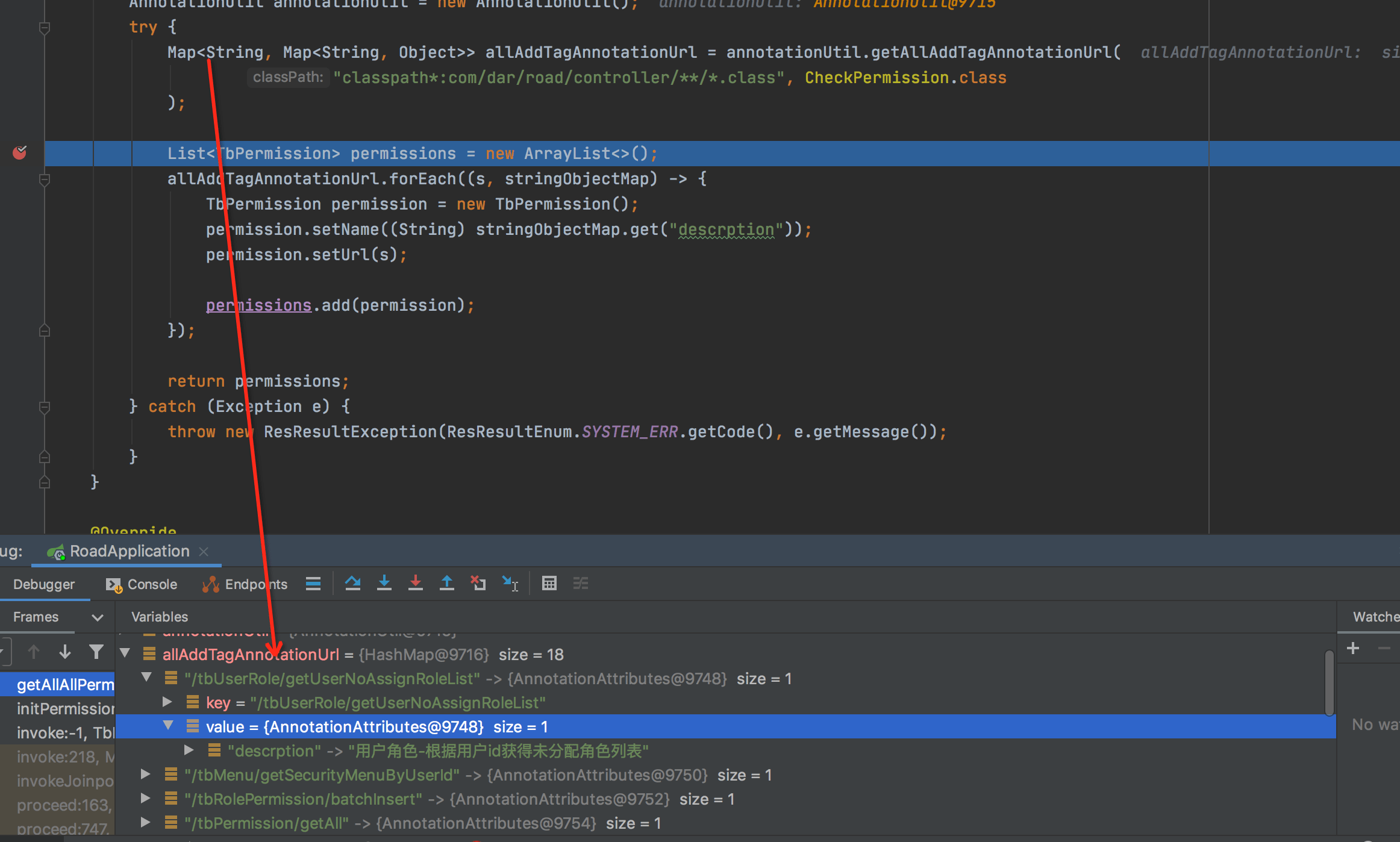import org.springframework.beans.factory.annotation.Autowired;
import org.springframework.core.io.Resource;
import org.springframework.core.io.ResourceLoader;
import org.springframework.core.io.support.ResourcePatternResolver;
import org.springframework.core.io.support.ResourcePatternUtils;
import org.springframework.core.type.AnnotationMetadata;
import org.springframework.core.type.MethodMetadata;
import org.springframework.core.type.classreading.CachingMetadataReaderFactory;
import org.springframework.core.type.classreading.MetadataReader;
import org.springframework.core.type.classreading.MetadataReaderFactory;
import org.springframework.stereotype.Component;
import org.springframework.web.bind.annotation.*;
import java.util.*;
@Component
public class TestCon {
@Autowired
private ResourceLoader resourceLoader;
private static final String VALUE = "value";
/**
* 获取指定包下所有添加了执行注解的方法信息
*
* @param classPath 包名
* @param tagAnnotationClass 指定注解类型
* @param <T>
* @return
* @throws Exception
*/
public <T> Map<String, Map<String, Object>> getAllAddTagAnnotationUrl(String classPath, Class<T> tagAnnotationClass)
throws Exception {
Map<String, Map<String, Object>> resMap = new HashMap<>();
ResourcePatternResolver resolver = ResourcePatternUtils.getResourcePatternResolver(resourceLoader);
MetadataReaderFactory metaReader = new CachingMetadataReaderFactory(resourceLoader);
Resource[] resources = resolver.getResources(classPath);
for (org.springframework.core.io.Resource r : resources) {
MetadataReader reader = metaReader.getMetadataReader(r);
resMap = resolveClass(reader, resMap, tagAnnotationClass);
}
return resMap;
}
private <T> Map<String, Map<String, Object>> resolveClass(
MetadataReader reader, Map<String, Map<String, Object>> resMap, Class<T> tagAnnotationClass)
throws Exception {
String tagAnnotationClassCanonicalName = tagAnnotationClass.getCanonicalName();
//获取注解元数据
AnnotationMetadata annotationMetadata = reader.getAnnotationMetadata();
//获取类中RequestMapping注解的属性
Map<String, Object> annotationAttributes =
annotationMetadata.getAnnotationAttributes(RequestMapping.class.getCanonicalName());
//若类无RequestMapping注解
if (annotationAttributes == null) {
return resMap;
}
//获取RequestMapping注解的value
String[] pathParents = (String[]) annotationAttributes.get(VALUE);
if (0 == pathParents.length) {
return resMap;
}
//获取RequestMapping注解的value
String pathParent = pathParents[0];
//获取当前类中已添加要扫描注解的方法
Set<MethodMetadata> annotatedMethods = annotationMetadata.getAnnotatedMethods(tagAnnotationClassCanonicalName);
Set<String> annotationTypes = annotationMetadata.getAnnotationTypes();
boolean allFlag = false;
if (annotationTypes.contains(tagAnnotationClassCanonicalName)) {
annotatedMethods = getMethodMetadata(annotationMetadata);
allFlag = true;
}
for (MethodMetadata annotatedMethod : annotatedMethods) {
//获取当前方法中要扫描注解的属性
Map<String, Object> targetAttr = annotatedMethod.getAnnotationAttributes(tagAnnotationClassCanonicalName);
//获取当前方法中要xxxMapping注解的属性
Map<String, Object> mappingAttr = getPathByMethod(annotatedMethod);
if (mappingAttr == null) {
continue;
}
String[] childPath = (String[]) mappingAttr.get(VALUE);
if (targetAttr == null || childPath == null || childPath.length == 0) {
if (!allFlag) {
continue;
}
}
String s = childPath[0];
boolean equals = s.substring(0, 1).equals("/");
boolean pathParentequals = pathParent.substring(0, 1).equals("/");
if (!pathParentequals) {
pathParent = "/" + pathParent;
}
String path = "";
if (equals) {
path = pathParent + childPath[0];
} else {
path = pathParent + "/" + childPath[0];
}
boolean isHas = resMap.containsKey(path);
if (isHas) {
throw new Exception("重复定义了相同的映射关系");
}
resMap.put(path, targetAttr);
}
return resMap;
}
private Set<MethodMetadata> getMethodMetadata(AnnotationMetadata annotatedMethod) {
Set<MethodMetadata> annotatedMethods = new HashSet<>();
Set<MethodMetadata> annotatedMethodsGet =
annotatedMethod.getAnnotatedMethods(GetMapping.class.getCanonicalName());
Set<MethodMetadata> annotatedMethodsPost =
annotatedMethod.getAnnotatedMethods(PostMapping.class.getCanonicalName());
Set<MethodMetadata> annotatedMethodsDelete =
annotatedMethod.getAnnotatedMethods(DeleteMapping.class.getCanonicalName());
Set<MethodMetadata> annotatedMethodsPut =
annotatedMethod.getAnnotatedMethods(PutMapping.class.getCanonicalName());
Set<MethodMetadata> annotatedMethodsRequest =
annotatedMethod.getAnnotatedMethods(RequestMapping.class.getCanonicalName());
annotatedMethods.addAll(annotatedMethodsGet);
annotatedMethods.addAll(annotatedMethodsPost);
annotatedMethods.addAll(annotatedMethodsDelete);
annotatedMethods.addAll(annotatedMethodsPut);
annotatedMethods.addAll(annotatedMethodsRequest);
return annotatedMethods;
}
private Map<String, Object> getPathByMethod(MethodMetadata annotatedMethod) {
Map<String, Object> annotationAttributes =
annotatedMethod.getAnnotationAttributes(GetMapping.class.getCanonicalName());
if (annotationAttributes != null && annotationAttributes.get(VALUE) != null) {
return annotationAttributes;
}
annotationAttributes = annotatedMethod.getAnnotationAttributes(PostMapping.class.getCanonicalName());
if (annotationAttributes != null && annotationAttributes.get(VALUE) != null) {
return annotationAttributes;
}
annotationAttributes = annotatedMethod.getAnnotationAttributes(DeleteMapping.class.getCanonicalName());
if (annotationAttributes != null && annotationAttributes.get(VALUE) != null) {
return annotationAttributes;
}
annotationAttributes = annotatedMethod.getAnnotationAttributes(PutMapping.class.getCanonicalName());
if (annotationAttributes != null && annotationAttributes.get(VALUE) != null) {
return annotationAttributes;
}
annotationAttributes = annotatedMethod.getAnnotationAttributes(RequestMapping.class.getCanonicalName());
return annotationAttributes;
}
}
上面做完之后直接调用






















 3万+
3万+











 被折叠的 条评论
为什么被折叠?
被折叠的 条评论
为什么被折叠?








